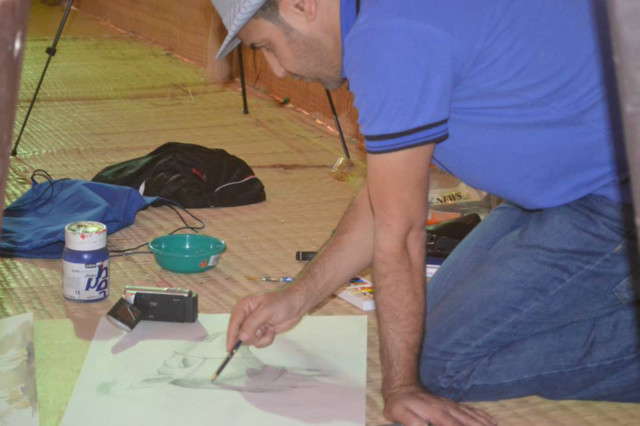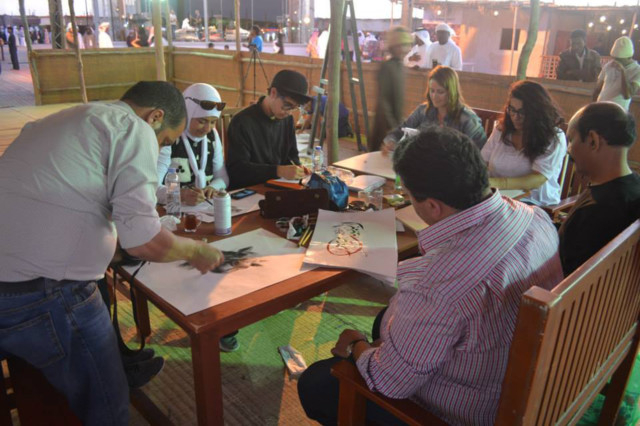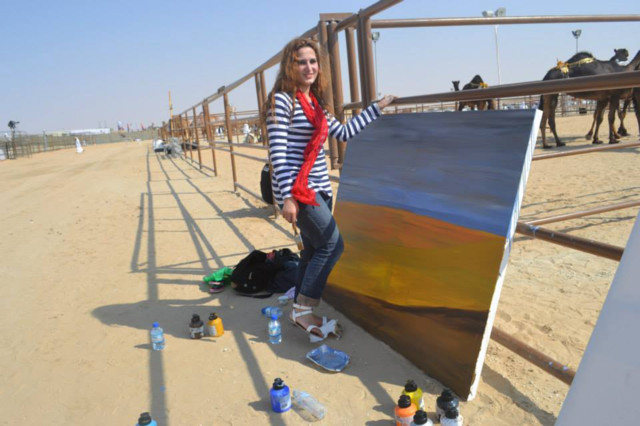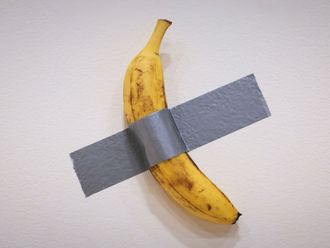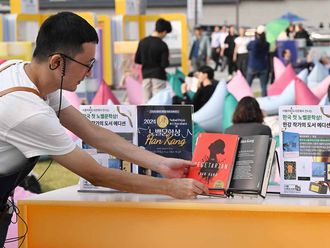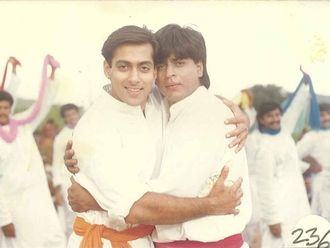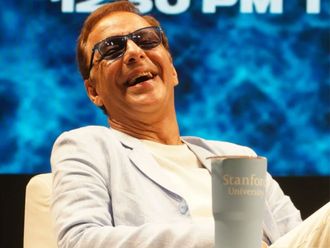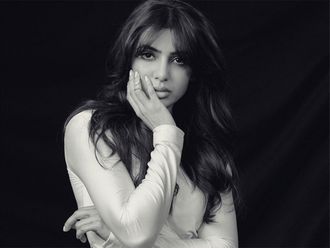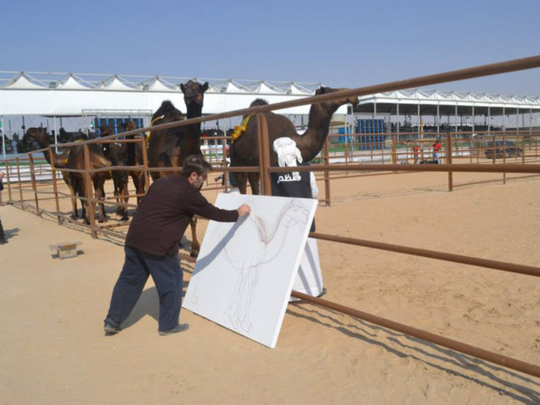
Snuggled within the heart of the Liwa desert, 225 kilometres west of Abu Dhabi, the Camel Art Festival opened on January 8. For a month the Liwa Art Hub campus was busy with resident artists and visitors from across the globe.
The event featured 25 international artists representing 11 countries. They produced 175 artworks and showcased them under the festival banner “Enduring Symbols of Arabia — The Camel: The Journey of Adoration”. The opening night saw more than 200 visitors at this venue, faraway from the city lights.
“It was a challenge to curate this event as artists were from different nationalities and they were trying to decipher a completely new culture [that of the UAE]. They had to master new techniques and adapt it all during this short term. For some artists, it was their first time face-to-face with a camel, let alone create an artwork of the nature,” says Charity ‘Cherrie’ Bandason, one of the three curators of the Camel Art Festival at Liwa.
Art Hub in Liwa concentrates on promoting three aspects of the community through art. “Art in science, culture and environment has been our focus. This time with the Dhafra Camel Festival around, we looked at connecting the dots to our cultural past,” says Ahmad Yafei, the founder and owner of Art Hub Liwa.
“A Camel Beauty Contest was among the many firsts for the participating artists. In the UAE, we have both Asayel (locals) and Majahim (dark-skinned) camels. It was interesting to learn the interaction between the camels and its owners,” says Bassam Al Selawai, curator, Camel Art Festival.
“It was a very unique experience for me. I had never come so close to camels to study them as subjects for my artworks. My work, a 3-metre-long acrylic canvas, shows the map of the UAE with interlocking camel patterns,” says artist Jennifer Pickering.
Artists were invited to live and work in Liwa during the Al Dhafra Camel Festival, as an opportunity to learn about the relationship between the Bedouin and the camel and create paintings on this theme. “We spent our first 10 days attending the camel festival where we went to a camel beauty competition, camel races and a traditional souk. We were also invited as guests to the Mazrouei International Camp. It was at this camp where, sitting around a fire in the desert, I learnt that the UAE would not exist today were it not for the camel. In the past, the Bedouin peoples’ survival depended on the camel.
“Camels can regulate their body temperature, go without food or water for long periods and provide milk, which made it possible for the Bedouin to travel across the desert. For instance, moving from the date palms gardens in Liwa in the fall and winter to the Gulf for pearling during the summer months. That is why the s honour the importance of the camel in their history with festivals such as Al Dhafra,” Pickering says.
The camel is a symbol of endurance and perseverance. The UAE holds this animal close to its heart and believes that it is because of the camels that its ancestors could travel far and explore the finest settlements in this part of the region. Artists explored this integral relationship between the land that is now the UAE, its people and their camels.
The title of Jennifer Pickering’s painting, “Describe to Me the Desert”, is inspired from a poem by late Emirati poet Ahmad Rashid Thani. The poem translates to: Which wave/ They describe to me the desert/ And forget the grain of sand/ In a wave that still runs by the sea/ They describe my many steps/ On the shore/ While the sea does not know/ In which wave it had drowned.
Camels are more than just a figure to this region and its heritage. “The unique thing in the UAE is that the past, present, and the future are located in the same land. The past is never forgotten. It is alive within the people — in the houses, streets, markets and the hearts. The cultural and heritage festivals in the UAE are giving an excellent chance to expats from various countries to get a feel of the past and the present,” says Emirati photographer Sultan Kurrani.
“Among all the subjects pertaining to the UAE, Camels are of huge significance, especially to the Bedouin. For centuries, camels were not only the mode of transport in the desert, but also the main source of food, milk and wealth. The camels were the backbone of the goods transportation, and it used to be the currency that time. Even today, camels plays a big role in many tribes that belong to the Arabian Peninsula,” he adds.
Participating artists at the included Bassam Al Selawi (Jordan), Maysoon Masalha (Jordan), Ahmad Shawish (Jordan), Rawaan Saadeh (Jordan), Mahmood Ahmad (India), Ben Amor Ryadh (Tunisia), Jennifer Pickering (Canada), Mohammad Quraish (Canada), Toomas Altnurme (Estonia), Shihab Vaippipadath (India), Maitha A.H. (UAE), Wafa Khazendar (UAE), Mohammad Al Sadoun (Iraq), Gaurav Mangla (India), Radhey Shyam (India), Babu Hussain (India), Sultan Karrani (UAE), Anas Abukrayem (Jordan), Mohammad Sobuh (Jordan), Nora Alqahtani (Saudi Arabia), Pandora Sazdovski (Macedonia), Sasho Sazdovski (Macedonia), Noor Al Azzam (Jordan), Simo Novakovic (Australia), Alaa Alrayyan (Jordan) and Charity ‘Cherrie’ Bandason (Zimbabwe).
Al Dhafra Festival
Every year during the Al Dhafra festival, Western Region highway gets busy with trucks arriving from all over the Arabian Gulf, bringing in camels from the region to compete. This annual festival of Bedouin traditions is organised by the Cultural Programmes and Heritage Festivals Committee — Abu Dhabi (CPHFC). Apart from 72 different competitions for the camel beauty shows, the festival organisers conduct other contests closely linked with Emirati traditions.
It is quite a sight to witness the ship of the desert all embellished in the traditional camel cover. The cover is a handmade Emirati ornament called Al Tarabish (colourful bunch of tassels) and Al Telli (woven in silver and golden threads). The event also includes a traditional souq, where Emirati women sell handmade products such as oil perfumes to dresses and spices. Another huge attraction of the festival is the camel auction, where racing camels fetch hundreds of thousands of dirhams to its owners.
The festival inspired in its form and content by the authentic Bedouin spirit, is dedicated to the protection of environmental and historical heritage.
Other competitions and activities that are part of this huge festival: the Mahaleb Competition, the Heritage Camel Race, the Arab Heritage Saluki Race, the Falcon Hunting Competition (falcons bred in captivity), the Purebred Arabian Horse Race, the Dates Mazayna, the Dates Packaging Competition, the Photography Competition, the Handicrafts Competition, the Classic Cars Competition, the Camel Auction, the Traditional Market and the Children’s Village.
Organisers hope that the festival will boost economic activity in the Western Region and promote Madinat Zayed’s tourism.
Art Hub Liwa
In his desire and quest to project the UAE’s rich cultural heritage at the grassroots level through the visual arts, Ahmad Yafei found the Art Hub in Abu Dhabi and later in Liwa.
The Bedouin lifestyle known for its simple, natural and fine history of hospitality has been the inspiring force behind the art hub’s programmes. UAE’s history is not complete without its camel. Bedouins believe it is God’s gift to them. Forty years ago camels played a remarkable role but today it is a symbol of art and appreciation.
The Camel Art festival inspired the artists to produce a wide range of artworks. The unique collection has had many buyers during the month-long event. Art Hub plans to display these artworks in all seven emirates shortly. Art Hub has also announced its expansion plans with a new museum dedicated to UAE’s art identity.
Known as artist B’lu, Archana R. D. is a freelance writer based in Dubai. She is also a student of global art business with the Sotheby’s.



